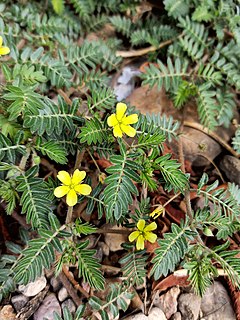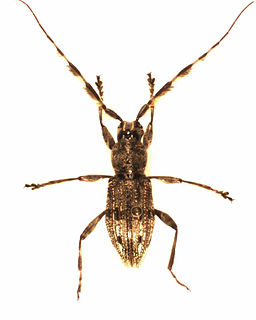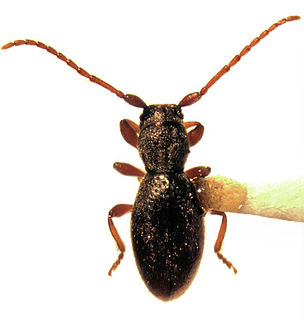Related Research Articles

Lumbricus terrestris is a large, reddish worm species thought to be native to Western Europe, now widely distributed around the world. In some areas where it is an introduced species, some people consider it to be a significant pest for out-competing native worms.

The South American tapir, also commonly called the Brazilian tapir, the Amazonian tapir, the maned tapir, the lowland tapir, in Portuguese anta, and in mixed Quechua and Spanish sachavaca, is one of the four widely recognized species in the tapir family, along with the mountain tapir, the Malayan tapir, and Baird's tapir. It is the largest surviving native terrestrial mammal in the Amazon.

Tribulus terrestris is an annual plant in the caltrop family (Zygophyllaceae) widely distributed around the world. It is adapted to grow in dry climate locations in which few other plants can survive. It is native to warm temperate and tropical regions in southern Eurasia and Africa. It has been unintentionally introduced to North America and Australia. An aggressive and hardy invasive species, T. terrestris is widely known as a noxious weed because of its small woody fruit – the bur – having long sharp and strong spines which easily penetrate surfaces, such as bare feet or thin shoes of crop workers and other pedestrians, the rubber of bicycle tires, and the mouths and skin of grazing animals.

Tribulus is a genus of plants in the family Zygophyllaceae and found in diverse climates and soils worldwide from latitudes 35°S to 47°N. The best-known member is T. terrestris, a widespread invasive species and weed.

Bombus terrestris, the buff-tailed bumblebee or large earth bumblebee, is one of the most numerous bumblebee species in Europe. It is one of the main species used in greenhouse pollination, and so can be found in many countries and areas where it is not native, such as Tasmania. Moreover, it is a eusocial insect with an overlap of generations, a division of labor, and cooperative brood care. The queen is monandrous which means she mates with only one male. B. terrestris workers learn flower colors and forage efficiently.

Notosuchus is an extinct genus of South American notosuchian crocodylomorph. It was terrestrial, living approximately 85 million years ago in the Coniacian or Santonian stages of the Late Cretaceous.

The terrestrial brownbul is a species of songbird in the bulbul family, Pycnonotidae. It is found in eastern and south-eastern Africa. Its natural habitats are subtropical or tropical dry forest, subtropical or tropical moist lowland forest, and subtropical or tropical moist shrubland.

Lysimachia terrestris is a plant in the family Primulaceae.
Terrestris, terrestrial in Latin, is a species name present in a number of species Latin names:

Parmenini is a tribe of longhorn beetles of the subfamily Lamiinae.

Somatidia is a genus of longhorn beetles of the subfamily Lamiinae, containing the following species:

Operational Land Forces Command - Army Operational Command is the Italian Army's major command tasked with the operational and administrative control of most of its combat forces. COMFOTER - COE reports directly to the Chief of Staff of the Italian Army. The command is based in Rome.
Somatidia nodularia is a species of beetle in the family Cerambycidae. It was described by Broun in 1913.
Somatidia spinicollis is a species of beetle in the family Cerambycidae. It was described by Broun in 1893.
Somatidia latula is a species of beetle in the family Cerambycidae. It was described by Broun in 1893. It contains the varietas Somatidia latula var. obesula.
Somatidia maculata is a species of beetle in the family Cerambycidae. It was described by Broun in 1921.
Somatidia kaszabi is a species of beetle in the family Cerambycidae. It was described by Stephan von Breuning in 1975.
Somatidia ptinoides is a species of beetle in the family Cerambycidae. It was described by Henry Walter Bates in 1874.
Somatidia helmsi is a species of beetle in the family Cerambycidae. It was described by David Sharp in 1882.

The Operational Land Forces Support Command is a major subdivision of the Italian Army tasked with providing support resources to the Operational Land Forces Command.
References
- ↑ BioLib.cz - Somatidia terrestris. Retrieved on 8 September 2014.